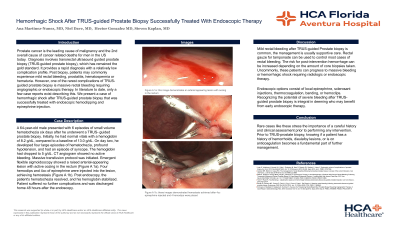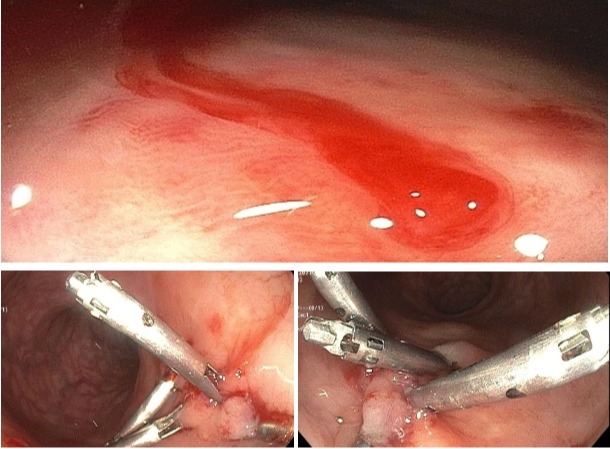Back


Poster Session D - Tuesday Morning
Category: Interventional Endoscopy
D0458 - Hemorrhagic Shock After TRUS-guided Prostate Biopsy Successfully Treated With Endoscopic Therapy
Tuesday, October 25, 2022
10:00 AM – 12:00 PM ET
Location: Crown Ballroom

Has Audio

Ana Martinez-Nunez, MD
Aventura Hospital & Medical Center
Aventura, FL
Presenting Author(s)
Ana Martinez-Nunez, MD, Niel Dave, MD, Steven Kaplan, MD, Hector Gonzalez, MD, Mina Ayad, MD
Aventura Hospital & Medical Center, Aventura, FL
Introduction: Prostate cancer is the leading cause of malignancy and the 2nd overall cause of cancer-related deaths for men in the US today. Diagnosis involves transrectal ultrasound-guided prostate biopsy (TRUS-guided prostate biopsy), which has remained the gold standard. It provides a rapid diagnosis with a relatively low complication profile. Post biopsy, patients may commonly experience mild rectal bleeding, prostatitis, hematospermia or hematuria. However, one of the rarest complications of TRUS-guided prostate biopsy is massive rectal bleeding requiring angiographic or endoscopic therapy. In literature to date, only a few case reports exist describing this. We present a case of hemorrhagic shock after TRUS-guided prostate biopsy that was successfully treated with endoscopic hemoclipping and epinephrine injection.
Case Description/Methods: A 64-year-old male presented with 6 episodes of small-volume hematochezia six days after he underwent a TRUS- guided prostate biopsy. Initially, he had normal vitals with a hemoglobin of 8.2 g/dL, compared to a baseline of 13.0 g/dL. On day two, he developed four large episodes of hematochezia, profound hypotension, and had an episode of syncope. The hemoglobin had dropped to 5 g/dL. CT angiogram showed no active bleeding. Massive transfusion protocol was initiated. Emergent flexible sigmoidoscopy showed a raised arterial-appearing lesion with active oozing in the rectum (Figure A). Four hemoclips and 4cc of epinephrine were injected into the lesion, achieving hemostasis (Figure A). Post endoscopy, the patient's hematochezia resolved and his hemoglobin stabilized. Patient suffered no further complications and was discharged home 48 hours after the endoscopy.
Discussion: Mild rectal bleeding after TRUS-guided Prostate biopsy is common, the management is usually supportive care. Rectal gauze for tamponade can be used to control most cases of rectal bleeding. Uncommonly, these patients can progress to massive bleeding or hemorrhagic shock requiring radiologic or endoscopic therapy. Endoscopic options consist of local epinephrine, sclerosant injections, thermocoagulation, banding, or hemoclips. Recognizing the potential of severe bleeding after TRUS-guided prostate biopsy is integral in deeming who may benefit from early endoscopic therapy.

Disclosures:
Ana Martinez-Nunez, MD, Niel Dave, MD, Steven Kaplan, MD, Hector Gonzalez, MD, Mina Ayad, MD. D0458 - Hemorrhagic Shock After TRUS-guided Prostate Biopsy Successfully Treated With Endoscopic Therapy, ACG 2022 Annual Scientific Meeting Abstracts. Charlotte, NC: American College of Gastroenterology.
Aventura Hospital & Medical Center, Aventura, FL
Introduction: Prostate cancer is the leading cause of malignancy and the 2nd overall cause of cancer-related deaths for men in the US today. Diagnosis involves transrectal ultrasound-guided prostate biopsy (TRUS-guided prostate biopsy), which has remained the gold standard. It provides a rapid diagnosis with a relatively low complication profile. Post biopsy, patients may commonly experience mild rectal bleeding, prostatitis, hematospermia or hematuria. However, one of the rarest complications of TRUS-guided prostate biopsy is massive rectal bleeding requiring angiographic or endoscopic therapy. In literature to date, only a few case reports exist describing this. We present a case of hemorrhagic shock after TRUS-guided prostate biopsy that was successfully treated with endoscopic hemoclipping and epinephrine injection.
Case Description/Methods: A 64-year-old male presented with 6 episodes of small-volume hematochezia six days after he underwent a TRUS- guided prostate biopsy. Initially, he had normal vitals with a hemoglobin of 8.2 g/dL, compared to a baseline of 13.0 g/dL. On day two, he developed four large episodes of hematochezia, profound hypotension, and had an episode of syncope. The hemoglobin had dropped to 5 g/dL. CT angiogram showed no active bleeding. Massive transfusion protocol was initiated. Emergent flexible sigmoidoscopy showed a raised arterial-appearing lesion with active oozing in the rectum (Figure A). Four hemoclips and 4cc of epinephrine were injected into the lesion, achieving hemostasis (Figure A). Post endoscopy, the patient's hematochezia resolved and his hemoglobin stabilized. Patient suffered no further complications and was discharged home 48 hours after the endoscopy.
Discussion: Mild rectal bleeding after TRUS-guided Prostate biopsy is common, the management is usually supportive care. Rectal gauze for tamponade can be used to control most cases of rectal bleeding. Uncommonly, these patients can progress to massive bleeding or hemorrhagic shock requiring radiologic or endoscopic therapy. Endoscopic options consist of local epinephrine, sclerosant injections, thermocoagulation, banding, or hemoclips. Recognizing the potential of severe bleeding after TRUS-guided prostate biopsy is integral in deeming who may benefit from early endoscopic therapy.

Figure: Figure A: Active oozing from the biopsy site (top). Status post epinephrine and hemoclip placement (bottom).
Disclosures:
Ana Martinez-Nunez indicated no relevant financial relationships.
Niel Dave indicated no relevant financial relationships.
Steven Kaplan indicated no relevant financial relationships.
Hector Gonzalez indicated no relevant financial relationships.
Mina Ayad indicated no relevant financial relationships.
Ana Martinez-Nunez, MD, Niel Dave, MD, Steven Kaplan, MD, Hector Gonzalez, MD, Mina Ayad, MD. D0458 - Hemorrhagic Shock After TRUS-guided Prostate Biopsy Successfully Treated With Endoscopic Therapy, ACG 2022 Annual Scientific Meeting Abstracts. Charlotte, NC: American College of Gastroenterology.
